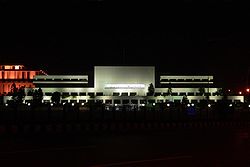

Islamabad, the capital of Pakistan, is home to numerous tourist attractions. [A] Daman-i-Koh, Margalla Zoo, Pakistan Monument, Faisal Mosque, Shakarparian, Lok Virsa Museum and Rawal lake view point are among the top tourist attractions in Islamabad. It also acts as a stop for journeys to Murree and Northern Pakistan when travelling from Pakistani provinces of Punjab, Sindh, and sometimes even Balochistan.










